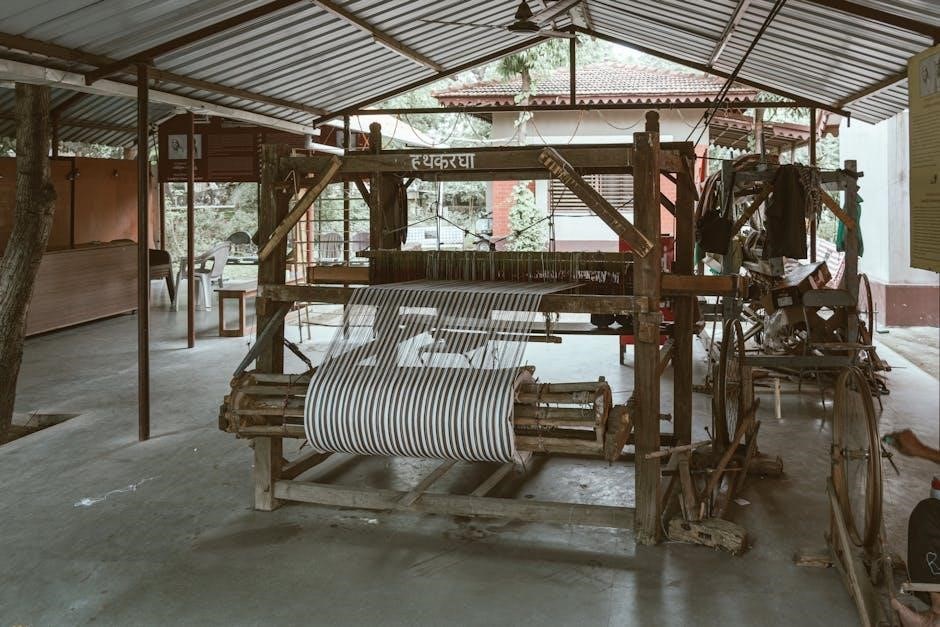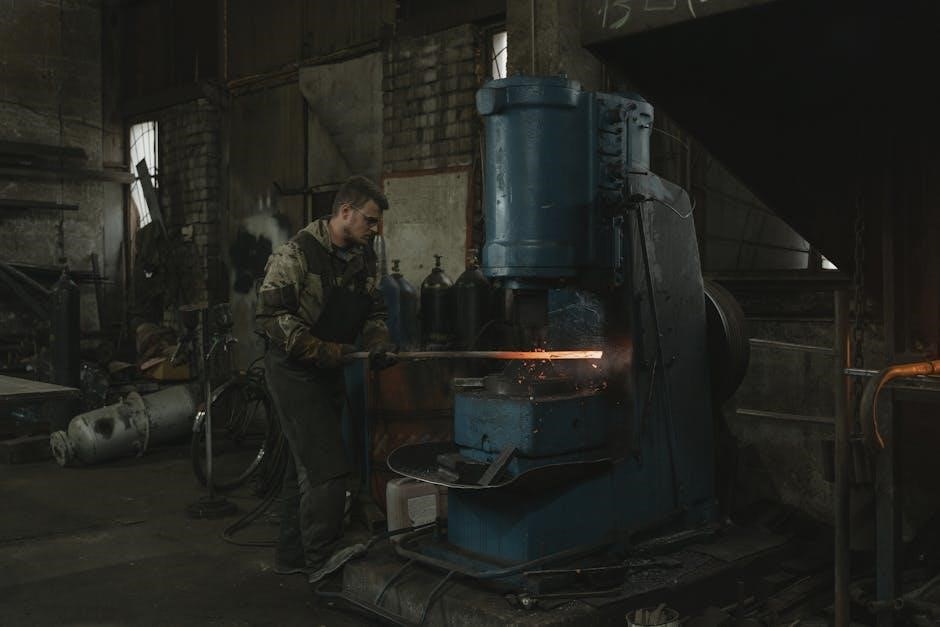Welcome to the Bridgeport Mill Manual. This comprehensive guide covers installation, operation, maintenance, and safety, helping both new and experienced users unlock the mill’s full potential.
1.1 Overview of the Bridgeport Mill Series
The Bridgeport Mill Series is a renowned line of milling machines known for their durability and precision. Designed for both hobbyists and professionals, these mills offer versatility in various machining applications. The Series I and Series II are the most popular models, catering to different workshop needs. With robust construction and advanced features, they deliver consistent performance. The mills are widely used in metalworking, woodworking, and prototyping. Their spindle speeds and feed rates ensure high accuracy. Whether for small-scale projects or industrial tasks, the Bridgeport Mill Series remains a trusted choice. Their reliability and adaptability make them a cornerstone in many workshops worldwide.
1.2 Purpose of the Manual
This manual serves as a comprehensive guide to help users understand and effectively operate the Bridgeport Mill. Its purpose is to provide clear instructions, safety precautions, and maintenance tips to ensure optimal performance. Designed for both novice and experienced users, the manual covers installation, operation, and troubleshooting. It aims to enhance productivity and safety while minimizing downtime. By following the guidelines outlined, users can maximize the mill’s capabilities and extend its lifespan. This manual is an essential resource for anyone seeking to master the Bridgeport Mill, offering detailed insights and practical advice for every stage of its use.
1.3 Target Audience
This manual is designed for a diverse range of users, including hobbyists, professionals, and educators. It caters to both novice and experienced individuals working with the Bridgeport Mill. Whether you’re setting up the mill for the first time or refining advanced machining techniques, this guide provides essential information. It is particularly useful for CNC operators, mechanical engineers, and woodworking enthusiasts. The manual’s clear instructions and detailed sections ensure that all users can safely and effectively operate the mill. By addressing the needs of various skill levels, the manual serves as a universal resource for anyone involved in machining and milling operations.
Installation and Setup
This section guides you through the installation and setup process, ensuring your Bridgeport Mill is ready for operation. It covers pre-installation checks, step-by-step installation, and initial calibration for optimal performance.
2.1 Pre-Installation Requirements
Before installing your Bridgeport Mill, ensure the site meets specific requirements. The area must be level, have adequate power supply, and sufficient space for operation. Check for proper ventilation to prevent dust buildup. Ensure all necessary tools and accessories are available. Review the manual thoroughly to understand the installation process. Verify that all components are included in the shipment. Prepare a clean, stable work surface to avoid damage during installation. Familiarize yourself with local safety regulations and ensure compliance. Proper preparation ensures a smooth and safe installation process, minimizing potential issues down the line.
2.2 Step-by-Step Installation Guide
Begin by unpacking the Bridgeport Mill carefully, ensuring all components are accounted for. Place the mill on a level, stable surface. Connect the power supply according to the specifications in the manual. Install any optional accessories as directed. Align the mill’s axes and secure them firmly. Follow the calibration steps precisely to ensure accuracy. Double-check all connections and settings before powering on. Once powered up, run a test cycle to verify proper function. Refer to the manual for specific instructions tailored to your model. Proper installation is crucial for optimal performance and safety.
2.3 Initial Setup and Calibration
After installation, power on the Bridgeport Mill and perform a system check to ensure all components function correctly. Calibrate the mill’s axes by following the manual’s specific instructions for your model. Set the tool offsets and align the spindle properly. Run a test cycle to verify accuracy and make adjustments as needed. Regular calibration ensures precise machining results. Consult the manual for detailed calibration procedures tailored to your mill’s specifications. Proper setup is essential for achieving optimal performance and maintaining accuracy in your machining operations.

Key Features of the Bridgeport Mill
The Bridgeport Mill is renowned for its robust mechanical design, precision engineering, and versatility. It offers optional accessories like digital readouts and advanced tooling, enhancing productivity and accuracy.
3.1 Mechanical Features
The Bridgeport Mill is built with a robust, rigid cast iron frame, ensuring stability and durability. Its Meehanite castings provide exceptional strength and resistance to wear. The spindle, a critical component, is precision-ground for accuracy and supported by high-quality bearings to handle varying speeds and loads. The table and knee assembly feature hand-scraped surfaces for smooth, precise movement. The headstock includes a quick-change gear system, enabling easy switching between operations. The mill also boasts a backlash adjustment system on the nuts and leadscrews, maintaining machining accuracy over time. These mechanical features combine to deliver reliable performance, making the Bridgeport Mill a trusted choice for both hobbyists and professionals.
3.2 Optional Accessories
The Bridgeport Mill offers a variety of optional accessories to enhance functionality and customization. These include digital readouts for precise measurement, power feeds for automated axis movement, and coolant systems to prevent overheating during machining. Additional tooling packages, such as quick-change tool holders and collet sets, streamline workflow. Optional workholding devices like vises and clamping kits improve material security. Ergonomic enhancements, such as adjustable lighting and improved visibility aids, are also available. These accessories allow users to tailor their mill to specific needs, whether for precision, efficiency, or safety. By incorporating these optional features, operators can optimize their machining experience and achieve superior results.
3.3 Advanced Functionalities
The Bridgeport Mill offers a variety of optional accessories to enhance functionality and customization. These include digital readouts for precise measurement, power feeds for automated axis movement, and coolant systems to prevent overheating during machining. Additional tooling packages, such as quick-change tool holders and collet sets, streamline workflow. Optional workholding devices like vises and clamping kits improve material security. Ergonomic enhancements, such as adjustable lighting and improved visibility aids, are also available. These accessories allow users to tailor their mill to specific needs, whether for precision, efficiency, or safety. By incorporating these optional features, operators can optimize their machining experience and achieve superior results.

Operating the Bridgeport Mill
Mastering the Bridgeport Mill involves understanding its controls, setting up tools, and performing precise machining operations. Always follow safety guidelines and pre-operation checks to ensure smooth functionality.
4.1 Starting the Mill for the First Time

Before starting the Bridgeport Mill, ensure all pre-operation checks are completed. Verify power supply, emergency stop functionality, and proper lubrication. Familiarize yourself with the control panel and safety features. Begin by powering on the mill and allowing it to cycle through any self-test routines. Check for unusual noises or vibrations. Perform a dry run without tools to ensure smooth operation. Once satisfied, proceed with initial tool setup and calibration. Always refer to the manual for specific startup procedures tailored to your model. Proper initialization ensures optimal performance and longevity of the machine. Safety and adherence to guidelines are paramount during this process.
4.2 Basic Machining Operations
Mastering basic machining operations on the Bridgeport Mill is essential for achieving precise results. Begin with setting up the workpiece securely on the table using clamps or a vise. Ensure the cutting tool is properly installed and aligned. Start with facing operations to create a flat surface, then proceed to drilling or milling. Use appropriate feed rates and spindle speeds based on the material and tool type. Always engage the spindle slowly and monitor vibrations. Practice basic profiling and slotting to build familiarity. Keep coolant or lubricant applied as needed to prevent overheating. Refer to the manual for specific settings and safety precautions. These foundational skills will enhance your machining efficiency and accuracy. Regular practice will refine your technique and ensure consistent results.
4.3 Advanced Machining Techniques
Advanced machining techniques on the Bridgeport Mill enable precise and complex operations. Climb milling enhances surface finish and tool life, while precision boring ensures accurate hole sizes. Angular milling allows for intricate shapes. Use digital readouts for exact positioning and CNC integration for automated processes. Implement thread milling for custom threads and helical milling for deep pockets. Advanced techniques require careful tool selection and setup. Always consult the manual for specific parameters and safety guidelines. Practice these methods to expand your machining capabilities and achieve professional-grade results. Regularly update your skills to stay proficient with evolving technologies and materials. This section provides detailed insights to help you master advanced operations effectively.
Maintenance and Care
Regular cleaning and lubrication are essential to prevent wear. Inspect moving parts frequently and replace worn components. Follow the manual for detailed care instructions to ensure optimal performance.
5.1 Daily Maintenance Routine

A daily maintenance routine is crucial for ensuring the longevity and optimal performance of your Bridgeport Mill. Begin by cleaning the machine thoroughly, removing any debris or chips from the work area and components. Inspect all moving parts, such as belts and gears, for signs of wear or misalignment. Lubricate all specified points as outlined in the manual to reduce friction and prevent overheating. Check the oil levels in the spindle and gearbox, topping them up if necessary. Finally, ensure all tools and accessories are securely stored and that the workspace is clear of obstructions. Regular attention to these details will help prevent downtime and maintain precision. Always refer to the manual for specific guidelines tailored to your model.
5.2 Lubrication and Cleaning
Proper lubrication and cleaning are essential for maintaining the Bridgeport Mill’s performance and longevity. Use high-quality machine oil or grease on all moving parts, such as spindle bearings and gearboxes, to reduce friction and prevent wear. Clean the machine regularly, removing metal chips and debris from the table, ways, and coolant troughs. Use compressed air or a soft brush to clear tight spaces. Avoid using harsh chemicals that could damage painted or anodized surfaces. For tougher grime, apply a mild solvent and wipe thoroughly with a lint-free cloth. Regular lubrication and cleaning ensure smooth operation, prevent corrosion, and maintain accuracy. Always follow the manual’s recommendations for specific lubricants and cleaning products.
5.3 Scheduled Servicing
Scheduled servicing is crucial for maintaining the Bridgeport Mill’s optimal performance and extending its lifespan. Follow the manufacturer’s recommended maintenance schedule, typically outlined in the manual. This includes checking and replacing worn or damaged parts, such as belts, gears, and bearings. Regularly inspect the spindle bearings and ball screws, ensuring they are properly aligned and lubricated. The coolant system should also be serviced to prevent contamination and ensure proper chip removal. Replace filters and fluids as specified to maintain hydraulic and coolant system efficiency. Keep a maintenance log to track servicing and plan future tasks. Regular scheduled servicing prevents unexpected breakdowns, ensures precision, and keeps the mill running smoothly for years. Always refer to the manual for specific intervals and procedures.

Troubleshooting Common Issues
This section helps identify and resolve common problems with the Bridgeport Mill, ensuring smooth operation. Use diagnostic techniques and maintenance checks to address issues promptly and effectively.
6.1 Identifying Common Problems
Identifying common issues with the Bridgeport Mill is crucial for maintaining productivity. Issues like vibration, noise, or inconsistent cuts often indicate misalignment or worn parts. Regularly inspect the spindle, bearings, and belts for wear. Listen for unusual sounds, as they can signal impending failures. Check for loose bolts or misaligned components, which may cause operational inaccuracies. Use diagnostic tools to monitor performance and refer to the manual for troubleshooting charts. Addressing problems early prevents costly repairs and downtime. Always prioritize safety when diagnosing issues, and consult a professional if unsure. Proper identification ensures timely resolution and extends the mill’s lifespan. Regular maintenance is key to minimizing downtime and ensuring optimal performance.
6.2 Diagnostic Techniques
Effective diagnostic techniques are essential for identifying and resolving issues with the Bridgeport Mill. Start with a visual inspection to check for wear, misalignment, or damage. Use specialized tools like vibration analyzers to detect imbalances in rotating components. Monitor operational sounds, as unusual noises often indicate specific problems. Utilize the mill’s control panel to review error codes or performance metrics. For software-related issues, run diagnostic programs to identify glitches. Regularly check lubrication levels and ensure all components are properly aligned. Documenting findings helps in tracking recurring issues and scheduling preventive maintenance. By combining these methods, users can efficiently diagnose and address problems, minimizing downtime and ensuring optimal performance. Regular diagnostics are crucial for maintaining the mill’s accuracy and longevity.
6.3 Solutions for Frequent Malfunctions
Addressing common malfunctions on the Bridgeport Mill requires targeted solutions. For spindle issues, ensure proper lubrication and check for worn bearings. If feed rates are inconsistent, inspect the servo motors and verify parameter settings. Misalignment of axes can be corrected by recalibrating the machine and tightening loose components. For software glitches, restart the control system or update to the latest firmware. Regularly clean debris from the table and ways to prevent operational interference. Lubricate all moving parts as specified in the manual. If problems persist, consult authorized service professionals. Preventative maintenance, such as routine inspections and timely part replacements, minimizes downtime and ensures reliable performance. Always refer to the manual for specific repair procedures.
Safety Precautions
Safety is paramount when operating the Bridgeport Mill. Always wear protective gear, ensure proper training, and follow operational guidelines to minimize risks and ensure safe operation.
7.1 General Safety Guidelines
Safety is critical when operating the Bridgeport Mill. Always wear appropriate personal protective equipment, including safety glasses and gloves. Ensure the machine is properly guarded, and loose clothing or jewelry is secured. Keep the work area clean and well-lit to prevent accidents. Never operate the mill while fatigued or distracted. Familiarize yourself with emergency stop locations and procedures. Use only approved tools and accessories, and avoid overreaching or leaning over moving parts. Properly secure workpieces to prevent unexpected movement. Follow all operational guidelines and manufacturer recommendations. Regularly inspect the machine for wear or damage. Consult the manual for specific safety protocols and adhere to all safety standards to ensure a safe working environment.

7.2 Personal Protective Equipment
Personal protective equipment (PPE) is essential for safe operation of the Bridgeport Mill. Always wear safety glasses or goggles to protect eyes from debris. Use gloves to prevent hand injuries and ensure a secure grip on tools. A face shield is recommended when performing operations that generate excessive dust or chips. Hearing protection, such as earplugs or earmuffs, is necessary to prevent noise-induced hearing loss. Wear steel-toe boots to safeguard feet from heavy objects. Ensure all PPE fits properly and is free from damage. Never operate the mill without appropriate protective gear, as it is your first line of defense against potential hazards. Always choose PPE that meets industry safety standards to maintain a safe working environment.
7.3 Emergency Procedures
In case of an emergency while operating the Bridgeport Mill, follow these steps to ensure safety. First, immediately disconnect the power supply to stop the machine. If a fire occurs, use a fire extinguisher rated for electrical or metal fires. Evacuate the area and alert others. For injuries, provide first aid and call emergency services if necessary. Keep a first aid kit nearby and ensure all personnel are trained in its use. In case of entanglement or equipment malfunction, do not attempt to free yourself without proper tools. Always have a emergency contact list accessible. Regularly review these procedures to ensure preparedness and prevent accidents.

Accessories and Customization
The Bridgeport Mill offers a range of accessories to enhance functionality, including tooling, attachments, and optional features. Users can customize their mill with upgrades to meet specific needs.
8.1 Available Accessories
The Bridgeport Mill offers a variety of accessories to enhance its functionality. These include tooling packages, such as end mills, drill bits, and collet sets, designed for precision machining. Additional accessories like power feeds and coolant systems can streamline operations, improving efficiency. Users can also opt for ergonomic enhancements, such as adjustable handles or LED work lights, to improve comfort and visibility. Furthermore, optional attachments, like rotary tables or vise packages, expand the mill’s capabilities for complex projects. These accessories are available through authorized dealers or the manufacturer, ensuring compatibility and quality. By equipping your mill with the right tools, you can maximize its performance and adaptability to meet your specific needs.

8.2 Customizing Your Bridgeport Mill
Customizing your Bridgeport Mill allows you to tailor its performance to your specific needs. Users can modify existing features or integrate custom parts to enhance functionality. For instance, adding a custom spindle or upgrading the control system can improve precision and efficiency. Additionally, custom tool holders or workholding solutions can be designed to accommodate unique project requirements. It’s important to ensure all modifications align with the mill’s design specifications to maintain optimal performance. Always consult the manual or contact authorized support before making significant changes. By personalizing your mill, you can achieve greater versatility and productivity in your machining tasks while ensuring safety and compatibility.
8.3 Upgrading Your Mill
Upgrading your Bridgeport Mill can significantly enhance its performance and adaptability. Consider upgrading to a high-torque spindle for improved machining efficiency or installing a CNC control system for automated operations. Additionally, upgrading the coolant system or integrating advanced tool changers can streamline your workflow. Software upgrades, such as updating the machine control software, can also unlock new functionalities. Always ensure that any upgrades are compatible with your mill’s existing configuration. Consult the manual or contact authorized support to verify compatibility and safety before proceeding. Regular upgrades not only extend the mill’s lifespan but also enable it to handle more complex and demanding projects with precision and reliability.
Welcome to the Bridgeport Mill Manual. This guide provides a comprehensive overview of your new Bridgeport Series 2, including installation, operation, maintenance, and safety tips for optimal use.
9.1 Summary of Key Points
Welcome to the Bridgeport Mill Manual. This guide provides a comprehensive overview of your new Bridgeport Series 2, including installation, operation, maintenance, and safety tips for optimal use. Designed for both new and experienced users, this manual ensures ease of use and helps unlock the mill’s full potential. By following the detailed instructions and adhering to safety guidelines, you can maximize productivity and extend the lifespan of your machine. Whether you’re setting up, operating, or maintaining your mill, this manual serves as your go-to resource for achieving professional results. For further learning, explore additional resources and stay updated on best practices.

9.2 Final Tips for Optimal Use
For optimal use of your Bridgeport Mill, always perform regular maintenance to ensure smooth operation. Select the right tools and set them up correctly to achieve precise results. Adhere to safety guidelines to prevent accidents and prolong machine life. Stay updated with the latest machining techniques to enhance productivity. Finally, consult this manual whenever you have questions or need clarification on any procedure. By following these tips, you can maximize the performance and longevity of your Bridgeport Mill, ensuring it remains a reliable tool in your workshop for years to come.
9.3 Resources for Further Learning
For further learning, explore the official Bridgeport Mill website, which offers detailed guides, tutorials, and FAQs. Enroll in certified training programs to gain hands-on experience. Join online forums and communities to connect with experienced users and share tips. Additionally, refer to specialized machining books and eBooks for advanced techniques. Regularly update your knowledge by subscribing to industry newsletters and attending workshops. These resources will help you master your Bridgeport Mill and stay informed about the latest developments in milling technology. Continuous learning ensures you maximize the machine’s capabilities and adapt to new challenges effectively.

